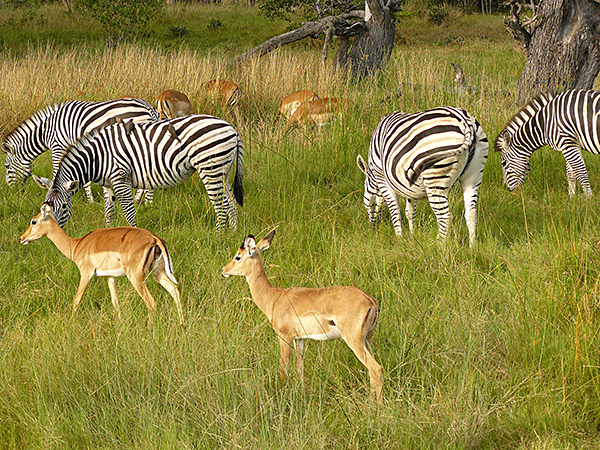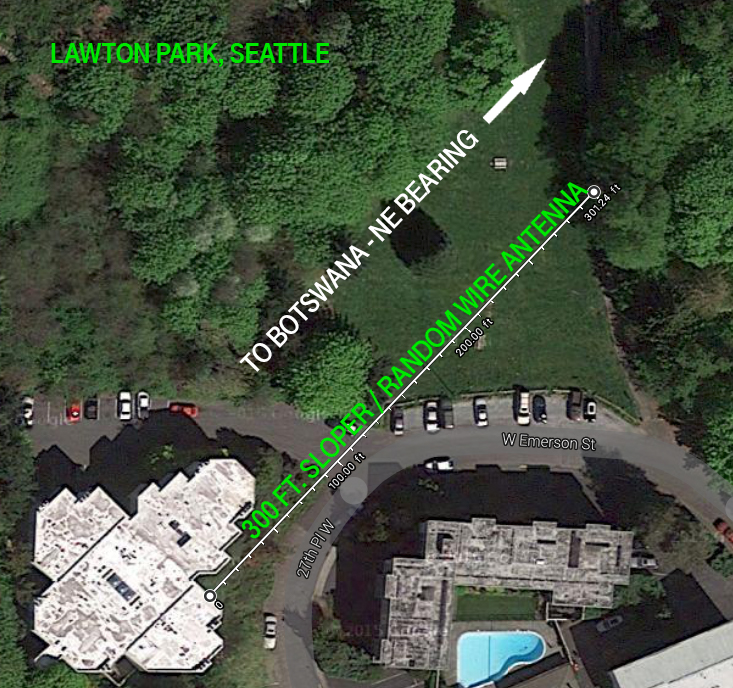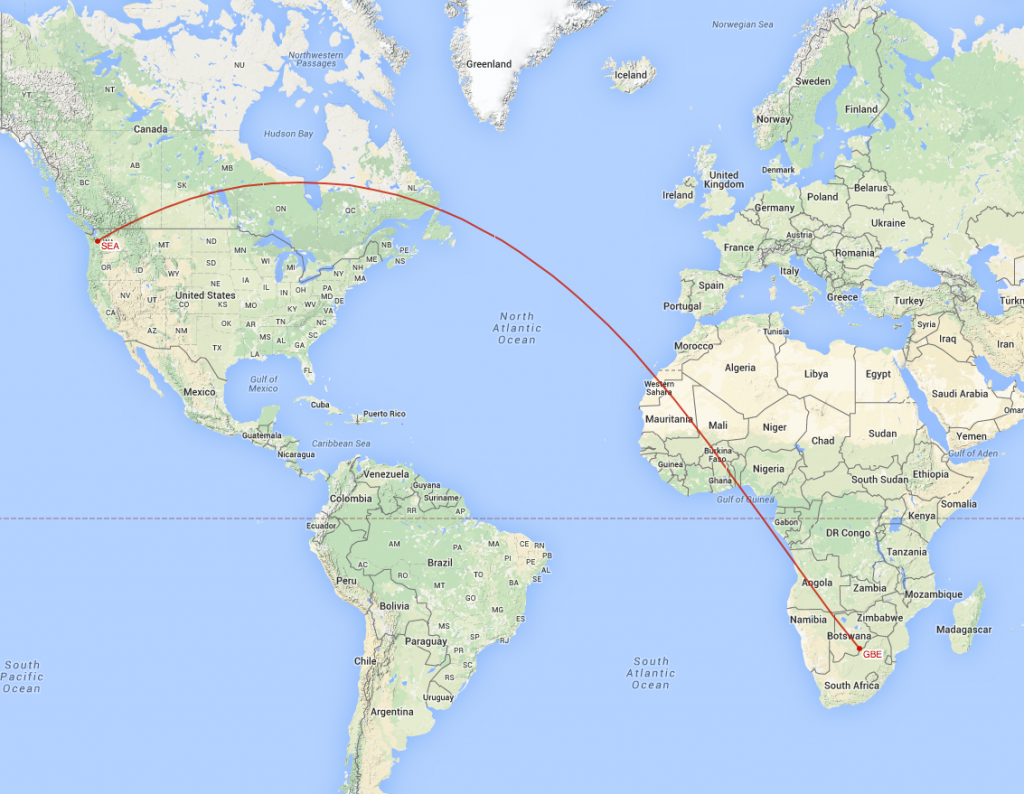No seasoned shortwave DXer can forget one of the most distinctive interval signals ever–the “barnyard animals” which marked the beginning of the broadcast day of Radio Botswana, Gaborone, for decades.
On its long-time frequency of 4820 kHz, Botswana was an occasional catch for me from the Seattle USA area. I yearned for clearer, more reliable reception of this station and other Africans which my East Coast USA DXer pals enjoyed!

Zebras mingle with other animals at Chobe National Park, Botswana.
It was always fun–and a DXing challenge–to catch Radio Botswana’s interval signal and sign-on announcements, but it was typically mid winter for reception in Seattle. Propagation on 60 meters needed to be favorable to enjoy anything other than a weak, barely listenable signal. Imagine my surprise and excitement when on the evening of December 27, 1987 I came upon the following signal booming in on 4820 kHz, far, FAR better than any previous Botswana reception. Indeed, their signal that evening surpassed in clarity even the Papua New Guinea and Indonesian “regulars” I would hear on the tropical bands from the Northwest USA.
This recording begins with the famous barnyard animals interval, the beautiful Botswana national anthem (Fatshe leno la rona, or This is Our Land in English) and is followed by a full list of broadcasting frequencies and times in English and the (presumed) Setswana language. That information is followed by a flute instrumental version of the Christian hymn Beautiful Savior, which introduces a short devotional or scripture message. The 10 minute recording wraps up with an a cappella children’s choir.
My receiving setup for this 1987 recording was an ICOM IC-R70 and a 300 foot long random wire antenna. Such a long antenna is unusual for the middle of an urban area, but I took advantage of living in a 3rd floor apartment across from a small city park. One midweek day, while most folks were at work, I managed to string out this long antenna with very small diameter braided steel wire from the 3rd floor apartment balcony to a distant treetop. This “sloper” antenna had significant directivity to the northeast, which happens to be the bearing for many African stations heard from the Pacific Northwest USA. The small diameter wire was suspended so high that it was virtually invisible from ground level.

Antenna orientation for 1987 reception of Radio Botswana. I’m sure this urban location is plagued by QRM and radio frequency interference now in 2016! My ICOM IC-R70 receiver handled the strong signals from nearby MW & FM broadcasters surprisingly well with the addition of a Grove Tun3 Mini-tuner preselector.
I continued to log Radio Botswana occasionally on 60 meters until the station eventually left the air (early 2000s I think), but I never heard them again with such a strong, clear signal as in late December 1987!
Guy Atkins is a Sr. Graphic Designer for T-Mobile and lives near Seattle, Washington. He’s a regular contributor to the SWLing Post.


QRM being worse now is also a deception of rose colored glasses. It’s about the same now and in a lot of cases worse back then from all the filament bulbs and noiser motored appliances and dimmer switches.
I’m assuming because of the time he had to receive torwards the east because that’s where the dark is. Otherwise that’s completely wrong, most african DX on the west coast comes from over said coast and pacific. That’s how I regularly pick up the 2 Madagascar and 1 Botswana site relaying the various international stations.
Thanks to the new KFS kiwi sdrs that’s even easier to snag now since you can have actual gain efficiency instead of just stringing longer and longer unity gain antennas at best.
Hi Samuel,
Only long path, sunrise period African DX comes from over the Pacific into the Northwest USA. It’s a southwest path, actually. In the 1990s I listened to South African stations with a SW beverage antenna from the WA coast at local dawn.
This was a short path late afternoon reception described in the article, however. The longwire antenna was northeast, which is the bearing of Botswana from Seattle.
Yes, the southern Africa trifecta was Botswana, Radio Lesotho, which always bit the
dust on shortwave, and Reunion on 2,446 khz. Excellent reception of Botswana and Lesotho was
often the clear clue that you had good reception for East Africa, and Reunion. And
of course if you had Botswana and Lesotho, the way was open for good reception of
Rhodesia/Zimbabwe and Zambia.
Thanks for the comments, Carl, Thomas, and Walt!
Yes, I seem to remember hearing of the recording studio origins of that interval signal also.
That lengthy random wire/sloper antenna came to an unusual demise one day, after it had been in place over a year. Because it had to span the city park with no intervening supports, I used the thin, strong steel “wire rope” as the antenna element and put it under a lot of tension to reduce sagging. The far end was high in a tree, probably a minimum of 50 feet high. As I mentioned, the receiver end was connected to a 3rd floor balcony. In addition, the entire building was on a small hill. I hadn’t taken any precautions to allow for swaying of tree branches at the far end.
Well, one sunny weekend afternoon I was relaxing at home and heard what sounded like a gunshot outside. Startled, I peeked out the living room window but didn’t see any activity. When I went to the balcony however I found dozens and dozens of feet of the steel antenna wire in a snarled mess scattered all over the balcony floor! The end of the wire was frayed like a bottle brush. The snapping, popping sound I had heard was the tightly strung antenna finally giving way! Later I explore the far end of the park (trying not to look suspicious :^) but I never located the remainder of the wire. I suspect it ended up a hopeless mess high in the tree tops!
73, Guy
I remember receiving that interval signal in the mid-90s in Charleston, on my first shortwave radio, a Sangean 505. I only had the cheap Sangean real antenna to extend the (largely) useless whip, and African catches were much enjoyed.
Fabulous reception, indeed, Guy! Now, I’m quite certain that I recall that the barnyard sounds were actually created in the studio, and not “in the field”. How exactly, I don’t recall. As for the sloper, can you imagine trying to do the same these days! Thanks for the memories!
Absolutely brilliant, Guy. That was phenomenal reception. At the time, I was using a Zenith Transoceanic (Royal 7000) inside the bedroom at my folks’ house in North Carolina. I remember, quite well, hearing the Botswana Interval Signal. I can’t think of a time I had that level of reception, but then again, I was using the (rather long) telescopic antenna on the Zenith inside a house. It’s amazing how much the RFI environment has changed since then.
Thanks for including the diagram of your ’87 sloper. Sounds like it, paired with the R70, was a winning combo!
What a fantastic write-up. I especially love the g.c. map and antenna plat.